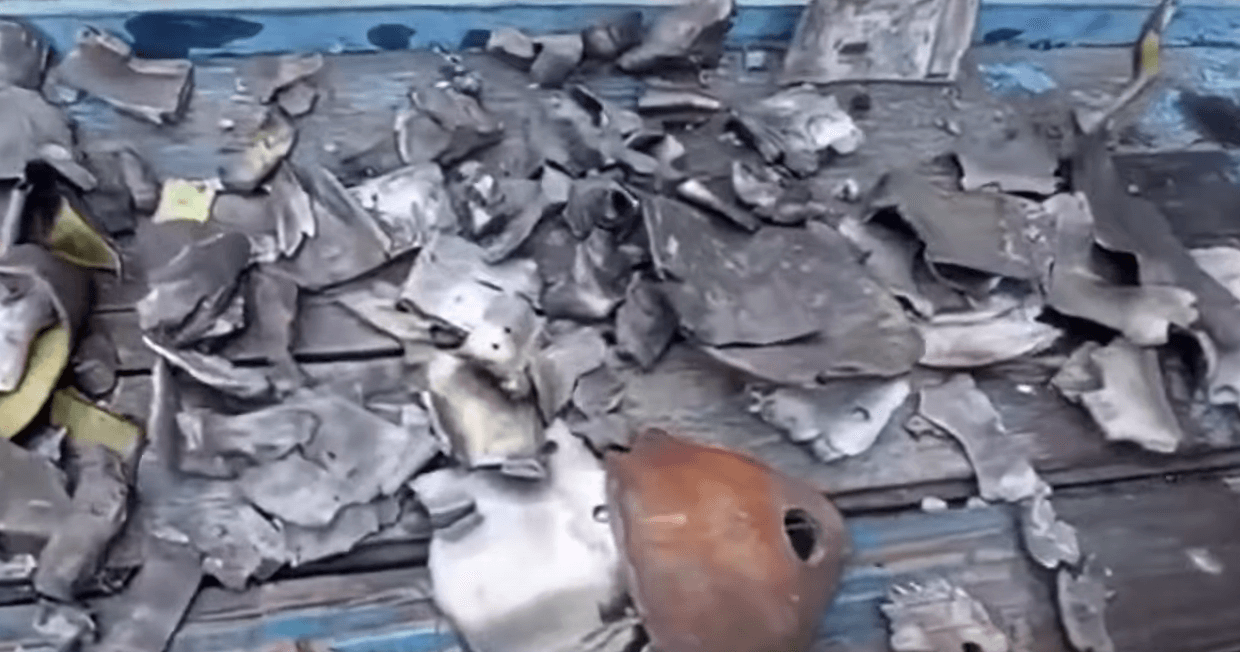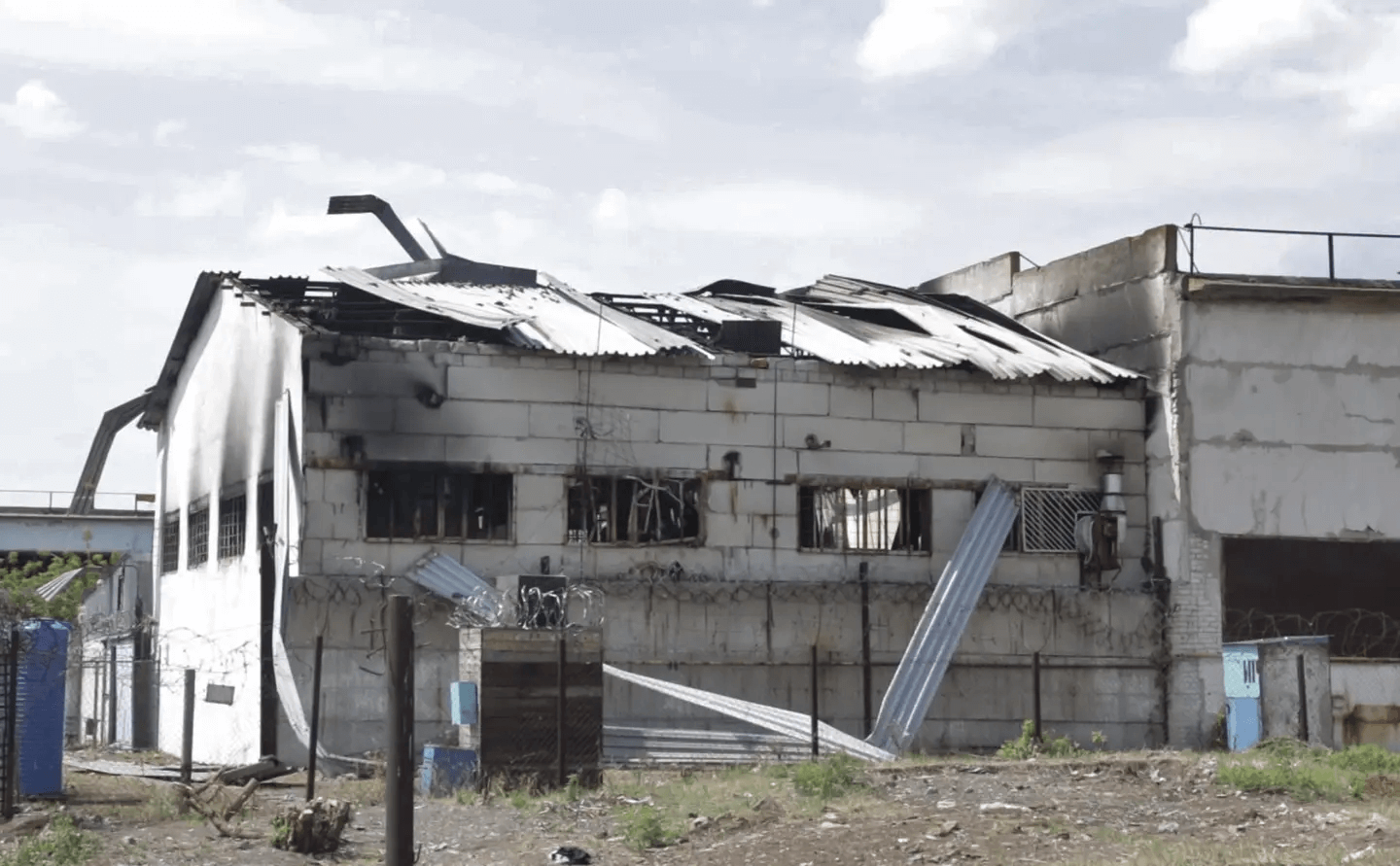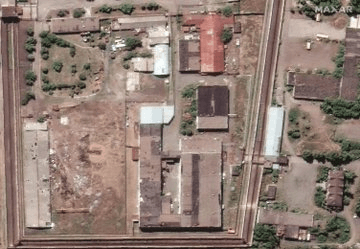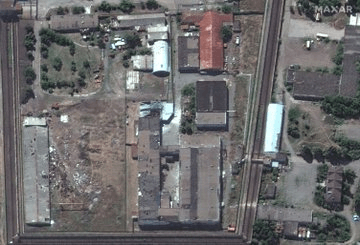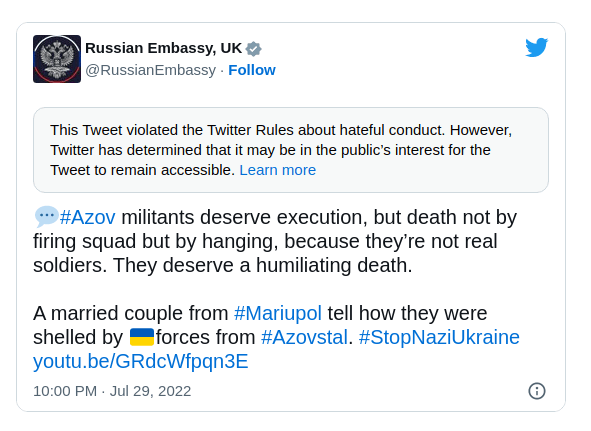On the night of July 28 to July 29, 2022, Russian occupying forces committed a mass killing of the military captives, the heroes of the defense of Mariupol, in Olenivka. This was a planned execution carried out by the Russians. The exact number of casualties and injuries is still unknown. Russia is obstructing the investigation by not allowing international organizations access to Olenivka. Legal processing of available testimonies and evidence is still ongoing.
Shelling or thermobaric explosion?
On July 29, 2022, the Russians reported an alleged shelling of the Vuhledar Colony No. 120, where they were holding prisoners of war. They claimed that the colony was attacked using “HIMARS” rockets and even displayed “fragments” of the projectiles as evidence. Denis Pushilin, the head of the so-called “DPR,” attributed the shelling to the prisoners of war supposedly starting to reveal crimes committed by the Ukrainian Armed Forces and Ukrainian authorities.
However, the evidence indicates a deliberate destruction of Ukrainian prisoners of war by Russia using a thermobaric explosion from within the building.
On the same day, July 29, the General Staff of the Ukrainian Armed Forces reported deliberate and targeted artillery shelling of Olenivka from the Russian side. Russia’s intention was to accuse Ukraine of war crimes and cover up evidence of torture against the captives. According to the commander of the Missile and Artillery Command of the Ukrainian Ground Forces, Ukrainian troops did not carry out any strikes in that direction.
On the same day, the Security Service of Ukraine (SSU) published interceptions indicating that the militants themselves carried out the terrorist attack using an explosive device. They placed it inside the colony’s premises. Additionally, the Russians deployed “Grad” rocket launchers on the colony’s territory, from which they launched attacks on the Ukrainian-controlled territory. However, they did not face any fire in response. Therefore, the SSU’s interceptions confirm the statements of the General Staff of the Ukrainian Armed Forces that Ukrainian artillery was not active in that direction.
The international intelligence community “InformNapalm” asserts that the available evidence refutes Russian propaganda.
At the time of the attack, the frontline was located 15 km away from Olenivka. Such a distance is within the range of conventional Ukrainian artillery. It is, therefore, illogical to use expensive “HIMARS” projectiles, which can also be traced back by the United States.
Moreover, the elements that the Russians present as the remains of American MLRs are rusty. This indicates their age, meaning that they were collected earlier and brought to the explosion site.
Photo of debris allegedly from “HIMARS” projectiles. Source: InformNapalm
In addition, the community points out that the building’s roof is not collapsed, some windows remain intact, and the beds are not scattered. These signs of scorching inside the building and on the bodies indicate the use of thermobaric weapons. The Ukrainian Armed Forces did not possess thermobaric projectiles capable of firing at such a distance.
Furthermore, on satellite imagery from “Maxar Technologies,” it is evident that there are no signs of missile strikes around the affected building. Only one building, where the prisoners were held, was impacted. If a “HIMARS” missile strike had occurred, the damage would have been much more extensive.
The building in Olenivka, which was allegedly attacked with HIMARS. July 29, 2022. Source: Associated Press
The Russian military base in Kadiivka destroyed with HIMARS.Source: Militarnyi
Satellite photo of Olenivka before the explosion
Satellite photo of Olenivka after the explosion
According to the Main Intelligence Directorate of the Ministry of Defense of Ukraine, the interrogations of the prisoners of war were conducted by investigators from the so-called “DNR state security ministry” in collaboration with representatives of the Wagner Private Military Company and the Russian Federal Security Service (FSB). During the interrogations, torture was used to mock, physically humiliate, and demoralize the Ukrainian prisoners of war. After psychological breakdowns, Russian media were supposed to record reports where Ukrainian captives would “confess” to war crimes and “criticize” the Ukrainian leadership.
As indicated by the Main Intelligence Directorate of the Ministry of Defense of Ukraine, Russia had no intention of exchanging the prisoners of war from Olenivka. Therefore, to cover up the traces of torture, the Russians killed the captives. To do this, the Wagner Private Military Company rigged the place of detention of Ukrainian prisoners with an easily ignitable substance, which led to a rapid spread of fire within the building.
CNN’s investigation also confirms that there was no “HIMARS” attack on Olenivka and, in general, it did not occur from the outside. The investigation also mentions testimonies from the captives who did not hear any sounds of missile approaching.
The international intelligence organization “Janes” informed CNN about signs of an extremely high temperature inside the building and the absence of debris.
On July 26, 2023, the United Nations High Commissioner for Human Rights, Folker Türk, stated that the tragedy in Olenivka, which occurred on the night of July 28 to July 29, 2022, was not caused by a “HIMARS” missile.
What did the German, Polish and French media write about the execution in Olenivka?
For the analysis, we selected media outlets from Germany, Poland, and France. To review what was written in the first two countries, we used a list of media from the “Propaganda Dairy” project. French media outlets were identified independently.
Germany
“Die Welt” covered mutual accusations from the Ukrainian and Russian sides in its materials. The media reported statements from representatives of Azov about seeking revenge against those responsible for the destruction of the prisoners of war in Olenivka, as well as the testimony of a civilian who was present in that filtration camp and reported on the torture.
“DW News,” in addition to mentioning the statements from the countries, reported that the International Committee of the Red Cross was unable to access the incident site.
“Die Zeit” described a report from a pro-Russian propagandist who interviewed the surviving wounded prisoners of war in Olenivka after the explosion. The propagandist actively tried to convince the injured captives that their wounds were the result of an attack with “HIMARS” missiles. The article, however, referred to the Russian version of events as “incredible.” There were no craters from explosions in the area supposedly struck, and only one building was damaged — the one where the prisoners from “Azovstal” were kept. Suspicion arises because no camp staff was injured, Russia prevented international organizations from accessing the site, and the accounts of those present in the filtration camp in Olenivka indicate systematic torture. The authors of the article noticed that before the terrorist attack, Russian Telegram channels began publishing supposed confessions from Azov fighters about war crimes. Later, Russian representatives used these “confessions” to claim that Ukraine had destroyed its own soldiers to prevent them from revealing the “truth about the Nazi regime.”
“Zweites Deutsches Fernsehen” not only reports events and versions but also pays attention to information from an anonymous military source from the “Associated Press.” The material mentions that Russia wants to fabricate evidence to hold Ukrainian military accountable.
“Frankfurter Allgemeine Zeitung” refers to intercepted conversations by the SSU of Russian military personnel and statements from the security service about the thermobaric explosion. The volunteer group “InformNapalm” points this out. At the time of the incident, Olenivka was 15 km away from the frontline, so the Ukrainian side could have used cheaper artillery shells. The media also highlights that observers consider Russian accusations against Kyiv absurd.
“Der Spiegel,” in its material from July 31, 2022, writes about events and facts that point to Russia’s culpability. It presents statements from the families of the captives who were in Olenivka, as well as from Russian and Ukrainian sides and volunteer organizations. Later, an article was published explaining that it is still impossible to determine the events in Olenivka precisely because Russia did not allow international organizations access to the explosion site.
“Bayerischer Rundfunk,” in addition to the previously known facts, reminded that the United Nations Secretary-General, António Guterres, disbanded the team that was supposed to investigate the terrorist attack. The reason cited was the impossibility of accessing the scene and ensuring the safety of the team members.
Summarizing the information from German media on the “white” list, it can be noticed that they attempted to objectively cover the information. They provided data from the Russian and Ukrainian sides, international organizations, and testimonies from those affected by Russian aggression. They paid attention to the arguments, and since there were more arguments against Russia, they concluded that Ukraine was not to blame.
We would like to emphasize the media from the “black” list separately. They either completely broadcasted Russian propaganda about the Olenivka shelling with “HIMARS” (Anti-Spiegel, RT DE, Linkezeitung.de, Newsfront, Report 24)) or simply ignored the event. Only authors from one media outlet on the list (“Reitschuster“) reported on the events in Olenivka as a terrorist attack performed by the Russian side.
Poland
Most of the Polish media from the “white” list wrote approximately the same information with references to international analysts and Ukrainian representatives. They rarely mentioned the Russian position and more often paid attention to the Ukrainian position or to the comments of representatives of third countries.
For instance, “Tvn24” mentioned both the Russian “HIMARS” version and the Main Intelligence Directorate’s claim of Wagner’s shelling of Olenivka, followed by the thermobaric explosion theory from within the building, the denial of access by the ICRC, and the Russian falsification of evidence. “Onet.pl”, “Polsat”, “Polskie radio lublin”, “Gazeta pl”, and “Wptech” covered the events in Olenivka in a similar manner.
Polish media outlets like “Pap” and “Wgospodarce” featured materials quoting French philosopher and publicist Bernard-Henri Lévy, who referred to the Olenivka incident as the “Ukrainian Katyn”. Deputy Foreign Minister Pavel Yablonsky made a similar comparison, which was published by “Polskie radio 24.”
“Defence24” dedicated a separate article to the Russian filtration camps in the occupied territories of Ukraine. The author pointed out that all these camps are under the control of the FSB and highlighted the use of illegal and cruel practices reminiscent of the Gulag system, including humiliation, beatings, electric shocks, and starvation, among others. The article also mentioned the terrorist attack in Olenivka and pointed to the deliberate explosion aimed at eliminating the prisoners.
“O2,” while reporting on the events and statements from various sides, noted that Russia often spreads disinformation in its reports, making their words unreliable.
Only one media outlet from the “black” list (“Sputnik Polska“) wrote about the terrorist attack in Olenivka, completely conveying Russian propaganda.
France
For the analysis of French media, we compiled a list of those media outlets that had information about the terrorist attack in Olenivka on their websites. It is worth noting that certain French media completely ignored this topic, such as the Parisian newspaper “L’Opinion,” the regional “Corse-Matin,” and the communist newspaper “L’Humanité.”
Let’s start with the most noticeable trend in the publications of the majority of French media, which would catch the attention of Ukrainian readers immediately. When writing about the colony in Olenivka, French journalists almost always use the term “territory of pro-Russian separatists.” Despite the fact that this term is no longer used in Ukraine, it is still widely used in France. For example, articles from “Le Monde,” “La Croix,” “L’Obs,” “L’Express,” “Challenges,” “Le Républicain Lorrain,” and others mention “separatists,” “territory of separatists,” or “statements from separatists.
Analyzing the information from French media about the nature of the explosion, we noticed that none of them mentioned the possibility that the death of the military prisoners could have been caused by the detonation of an explosive device placed inside the barracks.
Most French media, in their articles, simultaneously quote statements from representatives of Ukraine and Russia. However, there are certain peculiarities. Some media, such as “CNews,” only write in the headlines about Russia accusing Ukraine of killing military prisoners in Olenivka. “L’Express” immediately mentions the Russian version in the headline, and since a certain number of readers might only see this text in the feed and not open the full article, this statement will be the only thing they are acquainted with. “Challenges” published an article with a title stating that Russia invited UN experts to investigate the terrorist attack. However, articles with a similar statement about Ukraine were not published by this media outlet. “Nice-Matin” titled its article about the terrorist attack as: “Did Ukraine really bomb the Azov Regiment’s prison? Summing up.”
Many French media outlets quote Volodymyr Zelenskyi, Dmytro Lubynets, and Dmytro Kuleba. However, only some of them directly seek comments from Ukrainians or our allies. For example, “BFM TV” interviewed Alain Le Gouëfflec-Kremer, the co-founder of the initiative “Stand With Ukraine” in Europe, while “Nice-Matin” interviewed the families of the military prisoners. Nevertheless, the latter media outlet characterizes the Defenders of Azovstal as follows: “The defenders of Azovstal, grouped in underground tunnels, surrendered as prisoners due to lack of food and ammunition, but Ukrainians still consider them heroes.”
To conclude, it is worth mentioning the article from “Le Point” as it very accurately presents both perspectives on the Olenivka terrorist attack. On one hand, we see the words of President Volodymyr Zelenskyi, the spokesperson of the Ministry of Foreign Affairs, Oleh Nikolenko, the ombudsman Dmytro Lubinets, and the UK Ambassador to Ukraine, Melinda Simmons. On the other hand, the article quotes a tweet from the Russian embassy in the UK, which, on the morning after the attack on July 29, stated that the “Azov” servicemen should be killed. The Russian embassy also added information about their vision of how all members of Azov should be killed.
The post of the Russian embassy about the execution in Olenivka. Source: the official Twitter page of the Russian Embassy
Conclusions
Therefore, the necessity of broader coverage of the Olenivka terrorist attack abroad is evident. It is crucial to invite international organizations to cooperate in the investigation of the Olenivka terrorist attack. For instance, during a meeting in Geneva with the families of the victims, representatives of the UN revealed that Ukraine had not requested their mission to examine the bodies that were successfully repatriated from Olenivka on October 11, 2022.
It is important to understand that the case of the terrorist attack did not end with the attack itself. Investigations are ongoing, preparations are being made for international courts, and documentation of the crimes committed by the Russian occupying forces against Ukrainian defenders who were captured is underway. In this matter, cooperation with foreign colleagues is crucial, and bringing the case to the international arena is unquestionably significant.
Since January 2023, the public organization “Olenivka Families Community” has been operating. It is an initiative of more than a hundred families who work tirelessly on the investigation of the terrorist attack, highlighting its details in the media and at conferences, repatriating the surviving Heroes who were victims of the attack, and bringing to justice those who planned and carried out this execution.
Attention
The authors do not work for, consult to, own shares in or receive funding from any company or organization that would benefit from this article, and have no relevant affiliations
